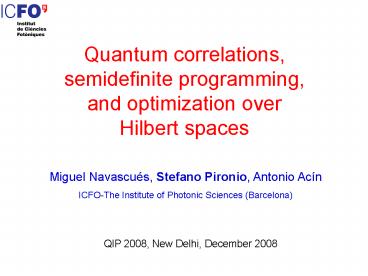Miguel Navascus, Stefano Pironio, Antonio Acn - PowerPoint PPT Presentation
1 / 15
Title:
Miguel Navascus, Stefano Pironio, Antonio Acn
Description:
Miguel Navascu s, Stefano Pironio, Antonio Ac n. ICFO-The Institute of Photonic ... in information processing tasks (nonlocal games, key distribution, communication ... – PowerPoint PPT presentation
Number of Views:64
Avg rating:3.0/5.0
Title: Miguel Navascus, Stefano Pironio, Antonio Acn
1
Quantum correlations, semidefinite
programming, and optimization over Hilbert spaces
Miguel Navascués, Stefano Pironio, Antonio Acín
ICFO-The Institute of Photonic Sciences
(Barcelona)
QIP 2008, New Delhi, December 2008
2
Introduction the scenario
3
Introduction the question
Are the probabilities P(abXY) quantum?
Semidefinite programming (this talk)
- Related questions
- are they classical (L)?
- are they no-signalling (NS)?
NS
Linerar programming
Q
Tsirelson Popescu-Rohrlich
Bell
L
4
Introduction motivation
- What are the constraints on correlations that
follow from the quantum formalism? - Which correlations are allowed within the
quantum formalism? - To which extent is QM useful in information
processing tasks (nonlocal games, key
distribution, communication protocols,) ? - Bound on violations of Bell inequalities
- Tools to detect the non-quantumness of
correlations observed in an experiment, i.e.,
Quantum Bell inequalities.
5
Quantum correlations definition
- The set of probabilities P(abXY) are quantum
if there exist - a Hilbert space H
- a state ? in H
- a set of measurement operators for
Alice - a set of measurement operators for
Bob - such that
No restrictions on H can be
where
proper measurements
separate systems
6
Quantum correlations necessary condition
Assume that there exist operators
reproducing P(abXY)
Consider the set of operators
Then the matrix with entries
is such that
Semidefinite programming
Do there exist values for the unknown parameters
such that ? If P(abXY) is
quantum, the answer to this question is yes.
7
Hierarchy of necessary conditions
Consider the set of operators
Example of constraints
projectors commutativity
Semidefinite programming
8
Hierarchy of necessary conditions
Let O(n) be the set of all product of n or less
operators and the corresponding
matrix. To determine if a given P(abXY) is
quantum, perform the sequence of SDP tests
YES
YES
YES
YES
NO
NO
NO
Is the hierarchy complete?
Optimization
relax
9
Completeness of the hierarchy
If P(abXY) satisfies the tests associated to
for all n1, then P(abXY) is quantum. (or
equivalently the sequence of relaxations fn
converges to f)
Proof uses property of matrix
to reconstruct state ? and
operators and acting on an
-dimensional space.
Rank loops
In general, the hierarchy converges only
asymptotically to the quantum set. But in some
cases we can conclude that P(abXY) is quantum
after a finitenumber of tests only! This happens
if In this case we can also extract operators
reproducing P(abXY)that act
on a finite-dimensional space.
10
Commutation vs tensor product
The hierarchy is complete in the sense that
(C)
commutation relation A and B measure separate
systems
In QI, we are used to
(T)
tensor product
- Clearly, (T) (C)
- For finite-dimensional systems (T) (C)
- For -dimensional systems (T) ?? (C)
Prob with finite sets of inputs/outputs ? finite
dim ??
Which definition? (C) is more general, usual
condition in QFT Werner 88. In practice
(numerical implementations), does not matter much
as only concerns asymptotic convergence.
Rank loop ? finite-dimensional system and (T)(C)
Otherwise upper-bound valid for both cases
11
Applications bounds on violations of Bell
inequalities
The maximal violation of a Bell inequality
is the maximum of a linear expression
ßP(abXY) in the probabilities P(abXY). It can
be written as
for some appropriate matrix B.
SDP
12
Applications bounds on violations of Bell
inequalities
Example CGLMP inequality 2 inputs / d outputs
CHSH Tsirelson, Wehner
Optimal Hilbert space d-dimensional
Other applications QI with untrusted devices -
QKD talk Thursday - private random number
generators Colbeck, Kent
13
Complexity of the hierarchy
- Consider measurement scenario with s inputs and d
outputs. - Matrix has rows and columns indexed
by all n-tuple products of operators
and - ? size of the matrix scales as (sd)n
- ? solve SDP ? poly(sd)n
- Not necessarily a defect of our method
- Kempe, Kobayashi, Matsumoto,Toner, Vidick have
shown that problem is NP-hard in the tripartite
case. - Even if bad scaling, in practice very good
- We usually get the optimal solution or good UB
after a few relaxations steps only.
14
Generalization of the method
Our method can be generalized to solve any
polynomial optimizationproblem of the form
where XX1,,Xn are hermitian operators acting
on a Hilbert space of arbitrary dimension,
and where F(X), Gi(X), and Hj(X) are hermitian
polynomials in the operators X. We provide a
sequence of SDP relaxations that converge to f
- Interest
- problems where one needs to optimize over
Hilbert spaces of arbitrary dimension - problems with large Hilbert space dimension
No need of explicit parametrization of Cd 1
operator 1 variable vs 1 operator d2
variables !!
15
CONCLUSIONS
- Hierarchy of SDP conditions to test if a given
set of bipartite probabilities is quantum - Valid for any number of inputs, outputs, and
parties - In practice, gives good UB after a few
relaxation steps - Can be generalized to solve polynomial
optimization problem over Hilbert spaces - Navascués, Pironio, Acín arXivquant-ph/0607119
in
preparation































